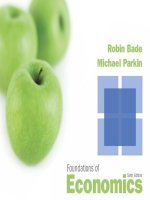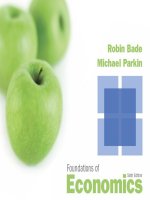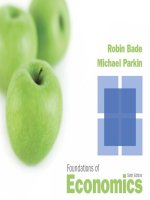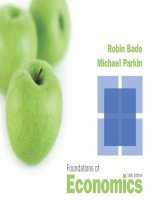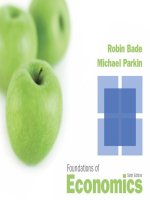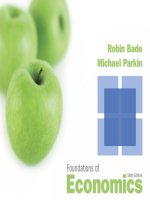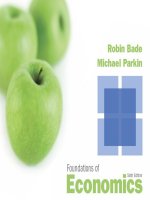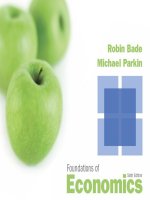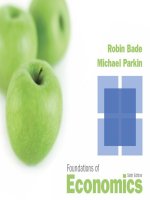Foundaions of economics 6th by robin bade ch03
Bạn đang xem bản rút gọn của tài liệu. Xem và tải ngay bản đầy đủ của tài liệu tại đây (1.39 MB, 42 trang )
© 2013 Pearson
Is wind power free?
© 2013 Pearson
3
The Economic Problem
CHAPTER CHECKLIST
When you have completed your
study of this chapter, you will be able to
1 Explain and illustrate the concepts of scarcity, production
efficiency, and tradeoff using the production possibilities
frontier.
2 Calculate opportunity cost.
3 Explain what makes production possibilities expand.
4 Explain how people gain from specialization and trade.
© 2013 Pearson
3.1 PRODUCTION POSSIBILITIES
Production Possibilities Frontier
Production possibilities frontier
The boundary between the combinations of goods and
services that can be produced and the combinations
that cannot be produced, given the available factors of
production and the state of technology.
The PPF is a valuable tool for illustrating the effects of
scarcity and its consequences.
© 2013 Pearson
3.1 PRODUCTION POSSIBILITIES
Figure 3.1 shows the
PPF for cell phones
and DVDs.
Each point on the
graph represents a
column of the table.
The line through the
points is the PPF.
© 2013 Pearson
3.1 PRODUCTION POSSIBILITIES
The PPF puts three features of production possibilities
in sharp focus:
• Attainable and unattainable combinations
• Efficient and inefficient production
• Tradeoffs and free lunches
© 2013 Pearson
3.1 PRODUCTION POSSIBILITIES
Attainable and Unattainable Combinations
Because the PPF shows the limits to production, it
separates attainable combinations from unattainable
ones.
Figure 3.2 on the next slide illustrates the attainable
and unattainable combinations.
© 2013 Pearson
3.1 PRODUCTION POSSIBILITIES
We can produce at any
point inside the PPF or on
the frontier.
We cannot produce at any
point outside the PPF such
as point G.
The PPF separates
attainable combinations
from unattainable
combinations.
© 2013 Pearson
3.1 PRODUCTION POSSIBILITIES
Efficient and Inefficient Production
Production efficiency is a situation in which we
cannot produce more of one good or service without
producing less of something else.
Figure 3.3 on the next slide illustrates the distinction
between efficient and inefficient production.
© 2013 Pearson
3.1 PRODUCTION POSSIBILITIES
1. When production is on the
PPF, such as at point E or
D, production is efficient.
2. If production were inside
the PPF, such as at point
H, more could be
produced of both goods
without forgoing either
good.
Production is inefficient.
© 2013 Pearson
3.1 PRODUCTION POSSIBILITIES
Tradeoffs and Free Lunches
A tradeoff is an exchange—giving up one thing to get
something else.
A free lunch is a gift—getting something without giving
up something else.
Figure 3.3 on the next slide illustrates the distinction
between a tradeoff and a free lunch.
© 2013 Pearson
3.1 PRODUCTION POSSIBILITIES
3. When production is on the
PPF, we face a tradeoff.
4. If production were inside
the PPF, there would be a
free lunch.
Moving from point H to
point D does not involve a
tradeoff.
© 2013 Pearson
3.2 OPPORTUNITY COST
The Opportunity Cost of a Cell Phone
The opportunity cost of a cell phone is the decrease in
the quantity of DVDs divided by the increase in the
number of cell phones as we move along the PPF.
Figure 3.4 illustrates the calculation of the opportunity
cost of a cell phone.
© 2013 Pearson
3.2 OPPORTUNITY COST
Moving from A to B, 1 cell phone costs 1 DVD.
© 2013 Pearson
3.2 OPPORTUNITY COST
Moving from B to C, 1 cell phone costs 2 DVDs.
© 2013 Pearson
3.2 OPPORTUNITY COST
Moving from C to D, 1 cell phone costs 3 DVDs.
© 2013 Pearson
3.2 OPPORTUNITY COST
Moving from D to E, 1 cell phone costs 4 DVDs.
© 2013 Pearson
3.2 OPPORTUNITY COST
Moving from E to F, 1 cell phone costs 5 DVDs.
© 2013 Pearson
3.2 OPPORTUNITY COST
Increasing Opportunity Cost
The opportunity cost of a cell
phone increases as more cell
phones are produced.
© 2013 Pearson
3.2 OPPORTUNITY COST
Opportunity Cost and the Slope of the PPF
The magnitude of the slope of the PPF measures
opportunity cost.
The slope of the PPF in Figure 3.4 measures the
opportunity cost of a cell phone.
The PPF is bowed outward, as more cell phones are
produced, the PPF becomes steeper and the
opportunity cost of a cell phone increases.
© 2013 Pearson
3.2 OPPORTUNITY COST
Opportunity Cost Is a Ratio
The opportunity cost of a cell phone is the quantity of
DVDs forgone divided by the increase in the quantity of
cell phones gained.
The opportunity cost of a DVD is the quantity of cell
phones forgone divided by the increase in the quantity
of DVDs gained.
When the opportunity cost of a cell phone is x DVDs,
the opportunity cost of a DVD is 1/x cell phones.
© 2013 Pearson
3.2 OPPORTUNITY COST
Increasing Opportunity Costs Are
Everywhere
Just about every activity has an increasing opportunity
cost.
© 2013 Pearson
3.3 ECONOMIC GROWTH
Economic growth is the sustained expansion of
production possibilities.
An economy grows when it develops better technology,
improves the quality of labor, or increases the quantity
of capital.
When an economy’s resources increase, its production
possibilities expand and its PPF shifts outward.
To study economic growth, we begin at the PPF with
consumption goods on one axis and a capital good on
the other.
© 2013 Pearson
3.3 ECONOMIC GROWTH
If we produce at point J,
we produce only cellphone factories and no
cell phones.
If we produce at point L,
we produce cell phones
and no cell-phone
factories.
At L, consumption
remains at 5 million cell
phones every year.
© 2013 Pearson
3.3 ECONOMIC GROWTH
1. But if we cut production
of cell phones to 3 million
this year, we can produce
2 cell-phone factories at
point K.
2. Then next year, our PPF
shifts outward because we
have more capital.
We can consume at a point
outside our original PPF,
such as K'.
© 2013 Pearson
